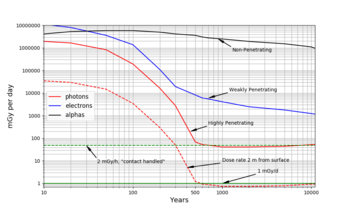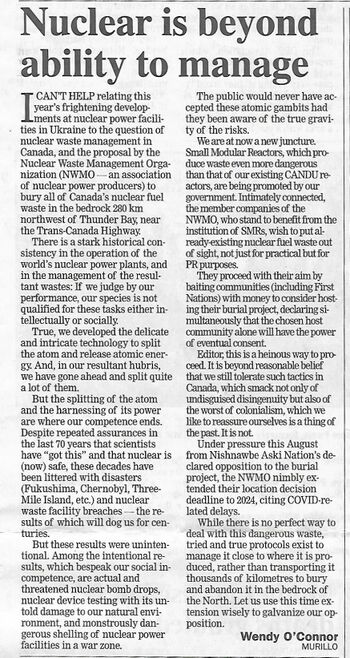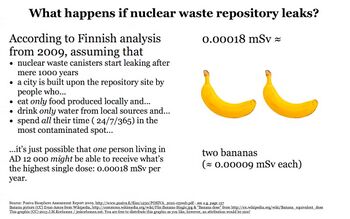Nuclear waste management/Debate Guide
Nuclear power is a controversial topic, and some of the controversies remain unsettled, even after the facts in the article are agreed on. This Debate Guide will provide a concise summary from each side of these unsettled issues. Much of this discussion is collected from Internet forums and other unreliable sources. We welcome updates with better sourcing.
Nuclear Waste Lasts Forever
Should we worry about a Planet of the Apes scenario in which future inhabitants of the Earth dig into a deep geologic repository?
From Forbes 2019:
The Staggering Timescales Of Nuclear Waste Disposal, Christine Ro, 2019/11/26
"High-level nuclear waste consists largely of spent fuel from nuclear reactors. ... This most potent form of nuclear waste, according to some, needs to be safely stored for up to a million years. Yes, 1 million years – in other words, a far longer stretch of time than the period since Neanderthals cropped up."
Reply:
From 600 year old spent nuclear fuel is just another poison, Jack Devanney, 13 Jan 2023, Substack.com:
Graph is from Devanney's Fig.4.
"There are three forms of radiation emitted by the used fuel: alpha particles, electrons, and photons (often called gamma rays). Alpha particles have no penetrating power. They are stopped by a piece of paper or a few centimeters of air. Electrons (confusingly called beta rays in this context) have very little penetrating power. Most are stopped by the outer layer of our skin. Alpha particles and most electrons must be swallowed to be a health hazard. They require little or no shielding. ... Photons on the other hand can have enormous penetrating power."
"Dose is the amount of radiation energy absorbed by our tissue. Dose is measured in joules per kg of tissue. Gray is a shorthand name for joules per kg. The graph is in milligrays per day (mGy/d). The key feature of Figure 4 is that photon decay is relatively rapid. By year 600, 99.999% of all the photon emitters are gone, relative to the end of year 1. In fact, the photon dose rate becomes so low that, according to US Department of Energy rules, the used fuel elements can be contact handled without any shielding at all. After year 600, the spent nuclear fuel must be swallowed in order to do any damage."
See Also:
Radioactive Waste – Myths and Realities World Nuclear Association, Updated January 2022.
Nuclear Waste is Unmanageable
"There is no plan for long term storage of radioactive waste."
Response:
Here is a table of the deep geological repositories under construction and planned.
https://world-nuclear.org/information-library/nuclear-fuel-cycle/nuclear-waste/storage-and-disposal-of-radioactive-waste.aspx
Let's distill the facts and rational argument from all the passion and attacks.
https://zionlights.substack.com/p/everything-i-believed-about-waste-was-wrong
- From The Oregonian, Oct 2021:
Hanford nuclear site’s contamination, growing risks to entire Northwest region
"The risk of an explosion that would cause a Chernobyl-like disaster is very real."
Response: from Jack Devanney, Principal Engineer, ThorCon USA Inc. 5 Feb 2023:
"The nuclear waste at Hanford is essentially the same as the nuclear waste from a commercial plant, although some of the chemical waste associated with plutonium extraction is not. The Hanford reactors produced the same fission products as any reactor.
Hanford is not a big risk. The worst dose rates are below background in large parts of the world. See Flop book Section 9.1. The "clean up" (really just moving things around) is a totally unnecessary boondoggle."
See also You want nuclear waste? I'll show you nuclear waste.
- From the Chronical Journal:
"Nuclear is beyond ability to manage" see Fig.1
Response:
From Al Scott 4 Sept 2022, commenting in the FaceBook forum No Nuclear Waste in Northwestern Ontario
""
The article makes nebulous reference to unnamed waste facility breaches as though this were a thing that has happened. Shame.
Despite this fabrication the article is well crafted to attempt to taint civilian nuclear power with the evils of nuclear weapons. This despite the fact that the megatons to megawatts program burned Soviet nuclear warheads for clean energy—nuclear reactors are the only way to permanently get rid of enriched weapons grade plutonium.
It attempts to evoke fear with reference to industrial accidents at Three mile island and Fukushima that caused more damage due to unfounded panic, than by the meagre effects of low level radiation. Nobody was killed by radiation despite Fukushima being arguably a worst case situation with a magnitude 9 earthquake and a colossal 40 metre tsunami. This ignores the fact that nearby nuclear facilities survived and even saved lives by sheltering hundreds of local residents against the wave.
As always it falls on Chernobyl to do the heavy lifting of demonizing humanity’s best chance to avoid disastrous climate change. Chernobyl, the pristine wildlife reserve referred to as a desolate wasteland by opponents. Chernobyl, the only ‘civilian’ nuclear reactor disaster ever to result in radiation deaths (probably less than 100 based on decades of scientific study). Chernobyl with a tragic casualty list similar in size to a jet plane crash but with truly devastating impact to humanity—accelerating climate change due to well funded anti nuclear fear mongering.
Radiation is a low risk carcinogen. We have evolved to exist in a naturally radioactive environment. Living in the most radioactive places on earth doesn’t measurably increase your risk of cancer. Scientists are still debating whether low levels of radiation may actually extend life expectancies. Many people still seek out old uranium mines and radioactive hot springs for their purported health benefits (many scientific papers on hormesis).
Spreading fear of radiation is irresponsible rhetoric and results in increased fossil fuel use which kills millions of people worldwide and promises to devastate ecosystems.
""
Here is a graphic illustration of what might happen if there is a leak from a Nuclear Waste Repository. See Fig.2
Cost of storage and disposal
- From a discussion on the cost of spent nuclear fuel storage in the forum Renewable vs Nuclear Debate:
"The US government has already spent over $9 billion dollars with future liabilities of $60 billion by 2030. This is for storage of 86,000 metric tons of spent nuclear fuel, increasing by 2,000 tons annually, from commercial reactors at 75 U.S. sites." - GAO Report 2021.
"$40 billion [the US Nuclear Waste Fund] is not a trivial [or unnecessary] cost. How long will it take to find and develop a permanent storage site? How much will the final bill be?"
Response from Jack Devanney, Principal Engineer, ThorCon USA Inc, and author of Why Nuclear Power Has Been A Flop email 14 July 2023:
"Deep Geologic Disposal is an order of magnitude more expensive
than dry cask. It is both unnecessary and stupid.
It is stupid because you are throwing away already refined U-238, which we will need for breeders.
It is stupid because it sends a clear message that spent fuel is uniquely dangerous.
In fact, after the [penetrating radiation] is gone, spent fuel is just another poison,
and not a particularly dangerous one."
Response from Captain Roger Blomquist, United States Navy (retired)] email 21 Aug 2023:
"Using the information in the spent fuel cost posting, cited as GAO numbers, I computed the cost per kWh if the actual commitment is $60B. It turns out to be 0.058 cents/kWh if no additional SNF is added. This is well below the 0.1 cents/kWh charged by DOE to pay for disposition, While $60B is certainly a lot of money, the fuel it will take care of produced staggering amounts of electricity, so the incremental cost is low (something like 1%, give or take, of the generating cost). Of course, the SNF disposal cost should be compared to the costs of incremental climate change damage (due to fossil fuel waste emissions) and the costs of mitigating climate change using other generating technologies."
From The Cost of Dry Cask Storage Section 2.3 in Jack Devanney's book Why Nuclear Power Has Been A Flop:
"A 500 cask facility capable of storing 8680 tons of used fuel, according to the developer, Holtec, will have an initial cost of 183 million dollars, exclusive of the casks which will run about $800,000 each.[104] This is a crazy number. The Holtex UMAX cask is a couple of 4.5 m high cylinders, requiring about 30 tons of steel and 30 tons of concrete. On an assembly line basis, the cost should be less than $100,000. The cask design life is 60 years."
Editor's Note: Using Holtec's "crazy numbers" ($800,000 per cask) and 30 tons of spent nuclear fuel per year for a 1 GW plant, Devanney gets 0.050 cents/kWh, very close to Blomquist's estimate of 0.058, which assumed that $60 billion would be the "actual commitment" of government funds. Most of this cost is for the heavily-armored casks, necessary for transportation, but not if the fuel assemblies can be transferred directly from the transport cask to an underground silo with no armor or shielding. David MacQuigg (talk) 13:11, 8 October 2023 (CDT)
Increased waste from Small Modular Reactors
National Academy of Sciences report:
Nuclear waste from small modular reactors, L.M.Krall, et.al., PNAS, 31 May 2022, https://doi.org/10.1073/pnas.2111833119
From the abstract:
- "the intrinsically higher neutron leakage associated with SMRs suggests that most designs are inferior to LWRs with respect to the generation, management, and final disposal of key radionuclides in nuclear waste."
- "water-, molten salt-, and sodium-cooled SMR designs will increase the volume of nuclear waste in need of management and disposal by factors of 2 to 30."
Reply from Jack Devanney, Principal Engineer, ThorCon USA Inc, email 5 June 2022:
- "All fission reactors produce essentially the same amount of fission products per thermal energy produced. This is immutable physics.
- Designs with higher thermal efficiency produce less fission products per kWh electricity produced, but this difference is less than a factor of two from the clunkiest LWR to the fanciest paper HTGR. Either way the amount of spent nuclear fuel represents a beautifully small problem."
For a critique of the NAS report see:
https://neutronbytes.com/2022/05/31/stanfords-questionable-study-on-spent-nuclear-fuel-for-smrs
Risk of Leaking Canisters
From the San Onofre Safety Website:
https://sanonofresafety.org/holtec-hi-storm-umax-nuclear-waste-dry-storage-system/
“Holtec HI-STORM UMAX canister storage systems and all other thin-wall nuclear waste canister storage systems are vulnerable to short-term cracking, radioactive leaks and potential explosions and criticalities.“
“Holtec Umax lids at San Onofre - Radioactivity at air vent (e.g., carbon-14) was 324 CPMs (0.97 microsieverts/hour)”
Editor's Note: 0.97 microsieverts is well under the 100 millisievert exposure threshold for measurable harm and comparable to background radiation levels 1 to 10 millisieverts per year. See Figures 1 and 2 in Fear_of_radiation.
“A canister breach in Texas or New Mexico can impact the water supply for eight states (the Ogallala aquifer), the breadbasket of the U.S.”
Holtec canisters:
Cannot be inspected inside or out
Cannot be repaired
Cannot be monitored or maintained to PREVENT radioactive leaks
No plan for failing canisters
From Holtec website: https://holtecinternational.com/products-and-services/hi-store-cis/overview/
“The life expectancy of the stainless-steel canister, which is the primary containment of the spent nuclear fuel, varies based on the environment. Conservative estimates put the life expectancy of the canister at hundreds of years. As part of the aging management program, there are regular inspections of canisters that will check the entire surface of a single canister, or part of the surface of multiple canisters. If these inspections would ever indicate an imperfection or crack, canisters would be re-packaged before a crack could propagate and a leak occur. There is sufficient time to re-package the canister since it would take many years for a crack to develop into a leak.”
“There are no liquid effluents or radioactive gas produced by the HI-STORE CIS facility. Therefore, there is no risk to the local groundwater or the quality of air at the site.”
“The HI-STORE CIS facility occupies less than the top 30 feet of the earth’s crust. Industrial activities such as mining of potash or extraction of hydrocarbons from the land, which occurs >1000 feet below-the-surface, will be entirely unaffected by the HI-STORE installation.“
Non-fuel waste
Much of the discussion about non-fuel waste is best done in the context of specific reactor designs. See ThorCon_nuclear_reactor/Debate_Guide#Waste_Management for example.
- Question in the FaceBook group Renewable vs Nuclear
"all the stuff on the primary loop. Pipes, pumps, wiring, blah blah. Obviously there is going to be mechanical and chemical wear on parts and they will need to be replaced like any power plant relying on heat -> steam -> turbine -> generator process. Parts will be be additionally exposed to neutrons and presumably undergo nuclear reactions and I assume some of those reactions will compromise their mechanical properties... eventually. How big of a deal is this? Is it slow, fast? What is the balance of fuel waste to non-fuel waste? Where do these parts go?"
Answer from Captain Roger Blomquist, United States Navy (retired) 8 Feb 2022:
"There are small concentrations of activated structural elements like cobalt. These typically have half-lives of years, not multiple decades. If they are recycled, then the workers doing the recycling will need to take (sometimes expensive) precautions to minimize their radiation exposure. I doubt that any such exposures would be harmful, although some might be. The precautions are quite likely far in excess of what is needed to prevent actual health effects."
Answer: from World Nuclear Association Recycling and reuse of materials from decommissioning
Recycling materials from decommissioned nuclear facilities is constrained by the level of radioactivity in them. This is also true for materials from elsewhere, such as gas plants, but the levels specified can be very different. For example, scrap steel from gas plants may be recycled if it has less than 500,000 Bq/kg radioactivity. This level however is one thousand times higher than the clearance level for recycled material from the nuclear industry, where generally anything above 500 Bq/kg may not be cleared from regulatory control for recycling.
- Question on Quora.com
How big a problem is irradiated steel and other non-fuel waste from a nuclear power plant?
Answer: from World Nuclear Association discussion of Recycling and reuse of materials from decommissioning:
Decommissioned steam generators from Bruce Power in Canada
"These steam generators were each 12m long and 2.5m diameter, with mass 100 tonnes, and contained some 4g of radionuclides with about 340 GBq of activity. Exposure was 0.08 mSv/hr at one metre." This compares to a chest x-ray (0.020 mSv) or the minimum exposure to show a measurable increase in cancer risk (100 mSv) XKCD Radiation Chart
Answer from Lyle McElhaney 30 March 2022:
Iron is an element that is difficult to make radioactive.
This table shows that iron-56, which is almost 92% of all naturally occurring iron, requires three neutron absorptions before it becomes radioactive, and two absorptions for another 2% of the material. A single absorption is a low probability event for any given iron nucleus; absorbing three is a low probability to the third power. If it does happen, it results in iron-59 which beta decays to cobalt-59 (stable) with a half-life of 45 days.
Of course, it also shows that about 6% of iron will become unstable with the absorption of a single neutron. The resulting isotope decays by electron capture, which does not emit a particle other than a neutrino, and results in manganese-55, which is stable. So, no harm done by that other than possibly some gamma-rays.
The cobalt-59 resulting from a triple neutron capture could catch another neutron, becoming the dreaded cobalt-60, nemesis of the cobalt bomb. Cobalt-60 has a powerful gamma-ray emission as it beta decays with a half-life of around 5 years. This requires, as noted, 4 successive neutron captures with an intervening beta decay after the third. It is a very small probability event in concept; I don’t know what it is in practice.
Other materials - some do become radioactive when drenched with neutrons for an extended time. One would need to know what materials to analyze what happens.
Answer from Joe Waligora, Wrote the SNF transfer to dry storage training program, taught SNF transfer to field supervisors and union crews; led an SNF transfer crew.
On the handling of irradiated metal during decommissioning of large nuclear power plants:
Siempelkamp Nuclear Services Inc. was contracted at Zion to perform segmentation of the reactor vessel and internals. This work was done with the reactor cavity flooded. GTCC (Greater Than Class C waste) was loaded into transportable storage cask (TSC) liners under water by transfer crews. Loaded TSCs were removed from the water in a shielded transfer cask after the TSC lid was installed. TSC was then dewatered enough to weld the lid on, then dewatered completely, vacuum dried, and backfilled with helium for corrosion control. TSC was then transferred from the transfer cask to the concrete storage cask and placed at the Independent Spent Fuel Storage Installation (ISFSI). There are two casks of GTCC from each reactor stored at the ISFSI in the same designed and licensed cask as the fuel. Workers were protected from over exposure to radiation by strict compliance to procedures, and continual monitoring by radiation protection personnel.
EPRI has experience and technical reports on segmentation and packaging of reactor vessel internals that can be found on their website.



